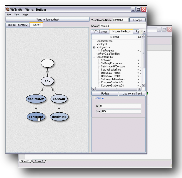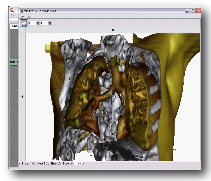Main Page
Hello, and welcome to the VisTrails Wiki.
What is it?
VisTrails is a new system that enables interactive multiple-view visualizations by simplifying the creation and maintenance of visualization pipelines, and by optimizing their execution. It provides a general infrastructure that can be combined with existing visualization systems and libraries.
By maintaining the provenance of both the visualization processes and data they manipulate, it enables reproducibility and simplifies the complex problem of creating and maintaining visualization products. This allows scientists to efficiently and effectively explore data through visualization: they can explore their visualization product by returning to previous versions of a dataflow (or visualization pipeline), apply a dataflow instance to different data, explore the parameter space of the dataflow, query the visualization history, and comparatively visualize different results.
Downloading
Get the open source version of VisTrails here.
Documents
Related Publications and Talks
Managing Rapidly-Evolving Scientific Workflows (by Juliana Freire, Claudio T. Silva, Steven P. Callahan, Emanuele Santos, Carlos E. Scheidegger and Huy T. Vo) Invited paper, in the proceedings of the International Provenance and Annotation Workshop (IPAW), 2006. presentation
Visualization in Radiation Oncology: Towards Replacing the Laboratory Notebook (by Erik W. Anderson, Steven P. Callahan, George T. Y. Chen, Juliana Freire, Emanuele Santos, Carlos E. Scheidegger, Claudio T. Silva and Huy T. Vo) SCI Institute Technical Report, No. UUSCI-2006-17, University of Utah, 2006.
Using Provenance to Streamline Data Exploration through Visualization (by Steven P. Callahan, Juliana Freire, Emanuele Santos, Carlos E. Scheidegger, Claudio T. Silva and Huy T. Vo) SCI Institute Technical Report, No. UUSCI-2006-016, University of Utah, 2006.
Managing the Evolution of Dataflows with VisTrails (by Steven P. Callahan, Juliana Freire, Emanuele Santos, Carlos E. Scheidegger, Claudio T. Silva and Huy T. Vo) IEEE Workshop on Workflow and Data Flow for Scientific Applications (SciFlow) 2006. presentation
VisTrails: Visualization meets Data Management (by Steven P. Callahan, Juliana Freire, Emanuele Santos, Carlos E. Scheidegger, Claudio T. Silva and Huy T. Vo) In Proceedings of ACM SIGMOD 2006. presentation
VisTrails: A Short Tutorial (by Steven P. Callahan, Juliana Freire, Emanuele Santos, Carlos E. Scheidegger, Claudio T. Silva and Huy T. Vo) Technical Report. University of Utah, 2005.
VisTrails: Enabling Interactive Multiple-View Visualizations (by Louis Bavoil, Steven P. Callahan, Patricia J. Crossno, Juliana Freire, Carlos E. Scheidegger, Claudio T. Silva and Huy T. Vo) In Proceedings of IEEE Visualization, 2005. presentation
A poster on VisTrails applications
Documentation
User's Guide
Video Tutorial
Videos
Please note that some of these videos were generated using versions of VisTrails, and the interface might look different than the one available in the most up-to-date version.

|
Demonstration
This video shows basic usage of VisTrails by going through three examples. Some of the features shown are:
As this is an old version of the system, some of the features are not currently available. |

|
Radiation Oncology
This video shows how some of VisTrails features were used on a Radiation Oncology study. As this is an old version of the system, some of the features are not currently available. |
People
Principal Investigators
- Dr. Juliana Freire
- Dr. Claudio Silva
Current Team
- Erik Anderson
- Steven P. Callahan
- David Koop
- Emanuele Santos
- Carlos E. Scheidegger
- Nathan Smith
- Huy T. Vo
Previous Members
- Louis Bavoil
- Marcelo Nery dos Santos
- Wayne Tyler
Sponsors
This work has been partially supported by the National Science Foundation under grants IIS-0513692, CCF-0401498, CNS-0541560, OISE-0405402, OCE-0424602, the Department of Energy under the SciDAC program (SDM and VACET), IBM Faculty Awards (2005 and 2006) and a University of Utah Seed Grant.
